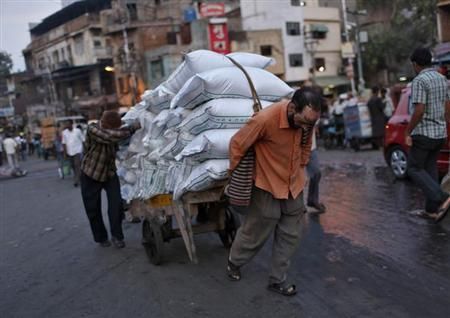 | « Back to article | Print this article |
It is time we used the current room for manoeuvre to address economic policy reforms and implementation issues, says Rahul Khullar.
 When balance of payments (BoP) difficulties manifest themselves as unsustainable current account deficits (CAD), economists line up the usual suspects: high domestic absorption (excess aggregate demand), large budgetary deficits and an overvalued exchange rate.
When balance of payments (BoP) difficulties manifest themselves as unsustainable current account deficits (CAD), economists line up the usual suspects: high domestic absorption (excess aggregate demand), large budgetary deficits and an overvalued exchange rate.
The remedies are well known; cutbacks in expenditure, reduce public dissaving and devaluation (or depreciation) of the exchange rate.
Do we need to look beyond the usual suspects?
Most certainly because often it is domestic policy distortions and inaction to correct them that lie behind the large CADs.
Addressing such structural issues is vital to providing more enduring solutions to BoP difficulties.
Examples drawn from a range of sectors illustrate the idea.
A decade ago, coal imports were 35 million tonnes (MT) per annum.
This year they are expected to cross 250 MT.
The imports are necessary because domestic production is insufficient.
Further, domestic prices are kept well below import parity prices and cannot incentivise domestic production.
Quantitative controls - coal linkages - remain intact. Even so, why should prices for assured supplies be below import prices?
A compromise - a pooled price (average of import and domestic prices) - has eluded decision for five years.
Does a monolithic monopoly (Coal India Ltd) suit the India of 2015?
Give Coal India's mines out on management contracts on a revenue-share basis.
The modern hotel industry is run on these lines: ownership is divorced from management.
Take the pharma sector. The last decade has witnessed the virtual demise of the domestic active pharmaceutical ingredient (API) industry.
India now imports two-thirds of its API requirements. Can it be credibly argued that a dynamic private sector cannot build a competitive indigenous industry?
Can't we consider public-private partnership (PPP) with the successful private pharma industry?
And, if not, why not a state-of-the-art public service undertaking for APIs?
The large-scale import of electronic products and intermediates has ballooned over 10 years.
And, much of the import is linked to domestic consumption, not investment.
Forecasts of five years ago predicted that this import boom was unsustainable.
A policy response has been five years in the making. Domestic production of pulses ranged between 12 and 15 MT per annum since 1960-61.
In 2004-05, imports were 2 MT; by 2011-12 they had crossed 4 MT. Import dependence is now over 22 per cent of domestic demand.
With pulses, there is the added problem that trade in international markets is thin.
So, whenever it is assessed that India's import will increase significantly, international prices shoot up.
When prices zoomed in 2010, it elicited a policy response: a sharp increase in minimum support price (MSP) for pulses. Producers responded and pulses production went up by as much as 3.5-4 MT in a year.
Since supply response to price signals has been clearly demonstrated, why not recast the MSP regime (which is focussed on wheat and rice) and alter relative prices in favour of pulses?
And, to insure against price volatility, why not consider building a buffer stock? Consider edible oils.
Over a decade, imports have trebled to 140 MT and import dependence has increased from 35 per cent to 70 per cent.
Policy responses: some argue for expanded production of oil palm.
Yet others canvass the case for soya, groundnut and mustard.
Why is action on all these points not possible? On invisibles (services), it is tragic that $10 billion (and growing) is spent annually on education overseas.
This is because of serious supply limitations of quality education both in public and private institutions.
More than 60 per cent of our universities and colleges are not accredited or certified.
At core, all failures of domestic policy.
Domestic policy also adversely impacts exports.
Take food grains. In 2011, the Food Corporation of India (FCI) had stocks of over 60 MT (well above buffer stock requirements). Grains were being stored in the open for want of silo space.
Nevertheless, the government refused to permit exports of wheat and non-basmati rice on grounds of food security.
Later, in 2012, some quantities were permitted for export.
Since then, wheat and rice prices have fallen by 40 per cent and 37.5 per cent respectively.
The export of iron ore was banned by the Supreme Court in 2011.
The ban stayed in force for three years (and six months more to resume production and mining).
India exports 100 MT, about half of domestic production. Over 2011-14, India lost market share and became an importer of iron ore. Not that options were not available.
By early 2012, the Department of Mines had established a system (not perfect) to track iron ore mined from source to port.
The government could also have considered a temporary expansion of canalisation of high-value iron ore (which it already does) with a clear sunset provision when a more durable traceability mechanism was in place.
It just did not happen. India is currently enjoying a reprieve on the BoP because import prices across the board are depressed.
However, a reversal of fortune will be harder to deal with because prices will increase across the board.
It is time we used the current room for manoeuvre to address economic policy reforms and implementation issues.
It might put flesh on the skeletal Make in India campaign.
If domestic policy is broken, let's fix it. As the advertising catchphrase goes: Just Do It.
Rahul Khullar is ex-chairman, Telecom Regulatory Authority of India